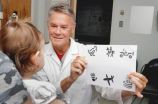(Press-News.org) This news release is available in French.
Montreal, July 13, 2014 — An international research project, led by the Research Institute of the McGill University Health Centre (RI-MUHC) in Montreal, reports that a new oral medication is showing significant progress in restoring vision to patients with Leber congenital amaurosis (LCA). Until now, this inherited retinal disease that causes visual impairment ranging from reduced vision to complete blindness, has remained untreatable. The study is published today in the scientific journal The Lancet.
"This is the first time that an oral drug has improved the visual function of blind patients with LCA," says the study's lead author, Dr. Robert Koenekoop, who is director of the McGill Ocular Genetics Laboratory at The Montreal Children's Hospital of the MUHC, and a Professor of Human Genetics, Paediatric Surgery and Ophthalmology at McGill University. "It is giving hope to many patients who suffer from this devastating retinal degeneration."
Jörgen, a 44-year-old Swede who was born with LCA, has long dreamed of a treatment for his blindness. He was enrolled in the MUHC study, along with others from North America, Europe, China and Brazil, and showed the most significant improvements of all the participants. "The drug changed my life," he says. "My visual acuity and visual field increased significantly. I can now go by myself into a shopping center or to the airport and even take the metro, which were unthinkable for me before. I hope many people can access the drug in a near future."
The study involved 14 participants from around the world with LCA ranging in age from 6 to 38 years old. Their blindness was caused by either mutations in the genes RPE65 or LRAT, leading to a serious defect in the retinoid cycle. The retinoid cycle is one of the most important cycles in the human retina because it produces a molecule called 11-cis retinal which has the special capacity to capture light and initiate vision. Patients with RPE65 or LRAT mutations cannot produce this crucial molecule thus the retinal cells cannot create vision, and slowly die.
"By giving patients with RPE65 or LRAT mutations an oral retinoid intermediate (QLT091001) most patients' vision improved rapidly. We discovered that a certain portion of the retinal cells that were not working because of the lack of 11-cis retinal could be woken up," explains Dr. Koenekoop. "Contrary to what was previously thought, children with LCA and defects in RPE65 or LRAT are not born with dead retinal cells; the cells can simply go dormant, and they can remain dormant for years before they eventually die. The oral drug we tested awakened these cells and allowed patients to see."
Ten out of the 14 patients expanded their visual fields; others improved their visual acuity. The research team performed special brain scans of the visual cortex, which showed marked improvements in brain activities in patients who also improved in field size and acuity. More research will now be conducted to learn more about the retinal function in blind people in relation to dosage and methodology.
"This revolutionary breakthrough to restore sight in children who are blind shows that investing in vision research over the long-term really can make miracles happen," said Sharon Colle, President and CEO of The Foundation Fighting Blindness, the largest charity funding sight-saving research in Canada
INFORMATION:
About the study
The paper entitled Oral 9-cis retinoid for childhood blindness due to Leber congenital amaurosis caused by RPE65 or LRAT mutations: an open-label phase 1b trial was coauthored by Robert K Koenekoop, Radwan Ajlan, Ayesha Khan and Janine D Mendola (Research Institute, McGill University Health Centre and McGill University, Montreal, Quebec, Canada); Ruifang Sui (Peking Union Medical College Hospital,Beijing, China); Juliana Sallum (Ophthalmology, Federal University of Sao Paulo, Sao Paulo, Brazil); L Ingeborgh van den Born (Medical Retina, Rotterdam Eye Hospital, Rotterdam, Netherlands); Anneke I den Hollander and Frans P M Cremers (Radboud University Medical Center, Nijmegen, Netherlands); Ava K Bittner and Gislin Dagnelie (The Wilmer Eye Institute, Johns Hopkins University, Baltimore, MD, USA); Ronald A Schuchard (Neurosurgery, Stanford University, CA, USA); and David A Saperstein (Vitreoretinal Associates of Washington, Seattle, WA, USA).
This work was supported by QLT Inc, the Foundation Fighting Blindness Canada, the Canadian Institutes of Health Research (CIHR), the Fonds de recherche du Québec – Santé (FRQS), Vision Health Research Network of the FRQS and The Montreal Children's Hospital Foundation.
Related links
The Lancet: http://www.thelancet.com
McGill University Health Centre (MUHC): http://www.muhc.ca
Research Institute of the MUHC: http://www.rimuhc.ca
Montreal Children's Hospital: http://www.thechildren.com
McGill University: http://www.mcgill.ca
For more information please contact:
Julie Robert
Public Affairs & Strategic planning
McGill University Health Centre
514-843-1560
public.affairs@muhc.mcgill.ca|
facebook.com/cusm.muhc|http://www.muhc.ca
MUHC researcher unveils novel treatment for a form of childhood blindness
2014-07-14
ELSE PRESS RELEASES FROM THIS DATE:
Australia drying caused by greenhouse gases
2014-07-13
NOAA scientists have developed a new high-resolution climate model that shows southwestern Australia's long-term decline in fall and winter rainfall is caused by increases in manmade greenhouse gas emissions and ozone depletion, according to research published today in Nature Geoscience.
"This new high-resolution climate model is able to simulate regional-scale precipitation with considerably improved accuracy compared to previous generation models," said Tom Delworth, a research scientist at NOAA's Geophysical Fluid Dynamics Laboratory in Princeton, N.J., who helped ...
Deep within spinach leaves, vibrations enhance efficiency of photosynthesis
2014-07-13
ANN ARBOR – Biophysics researchers at the University of Michigan have used short pulses of light to peer into the mechanics of photosynthesis and illuminate the role that molecule vibrations play in the energy conversion process that powers life on our planet.
The findings could potentially help engineers make more efficient solar cells and energy storage systems. They also inject new evidence into an ongoing "quantum biology" debate over exactly how photosynthesis manages to be so efficient.
Through photosynthesis, plants and some bacteria turn sunlight, water and ...
Researchers discover boron 'buckyball'
2014-07-13
PROVIDENCE, R.I. (Brown University) -- The discovery 30 years ago of soccer-ball-shaped carbon molecules called buckyballs helped to spur an explosion of nanotechnology research. Now, there appears to be a new ball on the pitch.
Researchers from Brown University, Shanxi University and Tsinghua University in China have shown that a cluster of 40 boron atoms forms a hollow molecular cage similar to a carbon buckyball. It's the first experimental evidence that a boron cage structure—previously only a matter of speculation—does indeed exist.
"This is the first time that ...
Study finds cause of mysterious food allergy, suggests new treatment strategy
2014-07-13
New research in Nature Genetics identifies a novel genetic and molecular pathway in the esophagus that causes eosinophillic esophagitis (EoE), opening up potential new therapeutic strategies for an enigmatic and hard-to-treat food allergy.
EoE is a chronic inflammatory disorder of the esophagus. The condition is triggered by allergic hypersensitivity to certain foods and an over-accumulation in the esophagus of white blood cells called eosinophils (part of the body's immune system). EoE can cause a variety of gastrointestinal complaints including reflux-like symptoms, ...
Antibody halts cancer-related wasting condition
2014-07-13
BOSTON – New research raises the prospect of more effective treatments for cachexia, a profound wasting of fat and muscle occurring in about half of all cancer patients, raising their risk of death, according to scientists from Dana-Farber Cancer Institute.
Many strategies have been tried to reverse the condition, which may cause such frailty that patients can't endure potentially life-saving treatments, but none have had great success.
Scientists reporting in the July 13 advanced online edition of Nature, led by Bruce Spiegelman, PhD, demonstrated that in mice bearing ...
Stanford researchers invent nanotech microchip to diagnose type-1 diabetes
2014-07-13
An inexpensive, portable, microchip-based test for diagnosing type-1 diabetes could improve patient care worldwide and help researchers better understand the disease, according to the device's inventors at the Stanford University School of Medicine.
Described in a paper to be published online July 13 in Nature Medicine, the test employs nanotechnology to detect type-1 diabetes outside hospital settings. The handheld microchips distinguish between the two main forms of diabetes mellitus, which are both characterized by high blood-sugar levels but have different causes ...
Study of noninvasive retinal imaging device presented at Alzheimer's conference
2014-07-13
LOS ANGELES – A noninvasive optical imaging device developed at Cedars-Sinai can provide early detection of changes that later occur in the brain and are a classic sign of Alzheimer's disease, according to preliminary results from investigators conducting a clinical trial in Australia.
The researchers will present their findings July 15 in an oral presentation at the Alzheimer's Association International Conference 2014 in Copenhagen, Denmark. They also were invited by conference organizers to participate in a "breaking news" news conference beginning at 7:30 a.m. Sunday, ...
Smell and eye tests show potential to detect Alzheimer's early
2014-07-13
COPENHAGEN, July 13, 2014 – A decreased ability to identify odors might indicate the development of cognitive impairment and Alzheimer's disease, while examinations of the eye could indicate the build-up of beta-amyloid, a protein associated with Alzheimer's, in the brain, according to the results of four research trials reported today at the Alzheimer's Association International Conference® 2014 (AAIC® 2014) in Copenhagen.
In two of the studies, the decreased ability to identify odors was significantly associated with loss of brain cell function and progression to Alzheimer's ...
Brain activity in sex addiction mirrors that of drug addiction
2014-07-11
Pornography triggers brain activity in people with compulsive sexual behaviour – known commonly as sex addiction – similar to that triggered by drugs in the brains of drug addicts, according to a University of Cambridge study published in the journal PLOS ONE. However, the researchers caution that this does not necessarily mean that pornography itself is addictive.
Although precise estimates are unknown, previous studies have suggested that as many as one in 25 adults is affected by compulsive sexual behaviour, an obsession with sexual thoughts, feelings or behaviour ...
When good gut bacteria get sick
2014-07-11
Boston, MA – Being sick due to an infection can make us feel lousy. But what must the ecosystem of bacteria, or microbiota, colonizing our guts be going through when hit with infection? A study from Brigham and Women's Hospital (BWH) has utilized unique computational models to show how infection can affect bacteria that naturally live in our intestines. The findings may ultimately help clinicians to better treat and prevent gastrointestinal infection and inflammation through a better understanding of the major alterations that occur when foreign bacteria disrupt the gut ...





